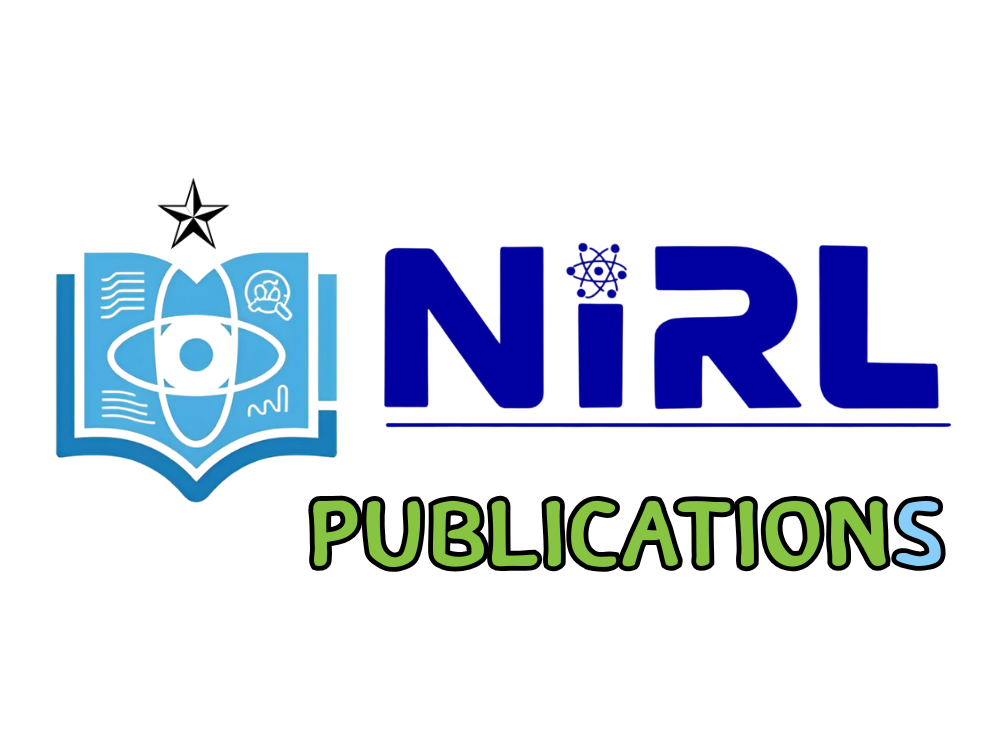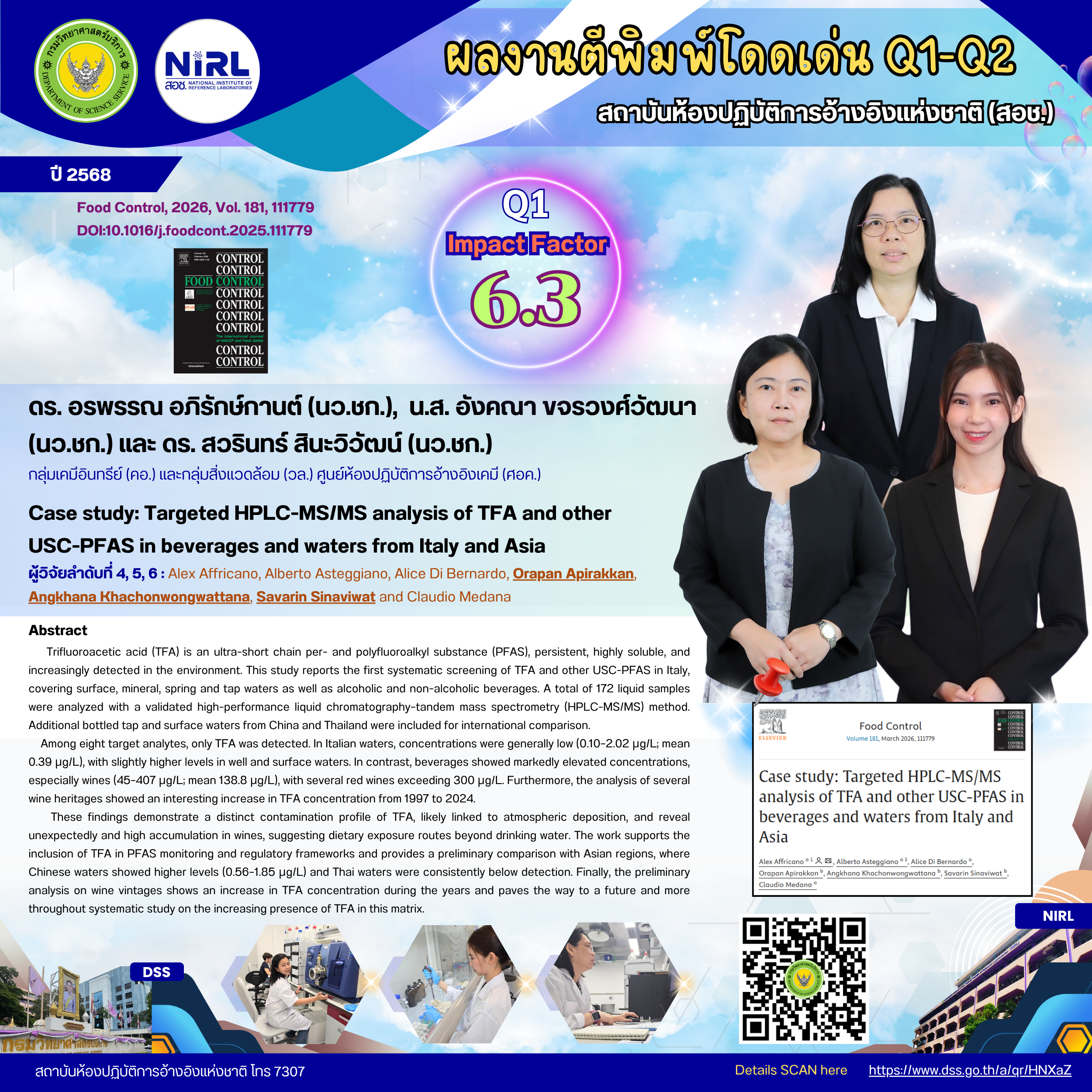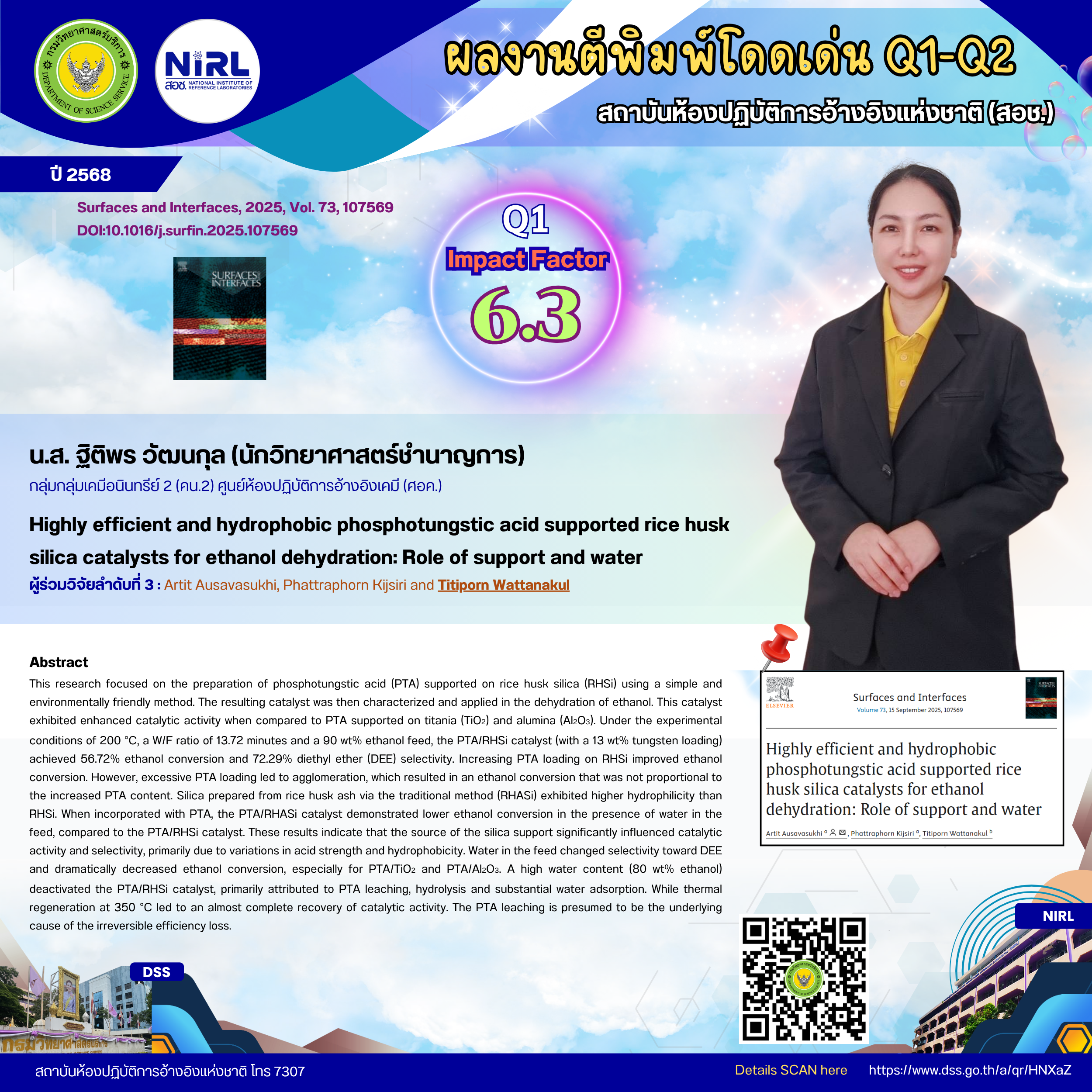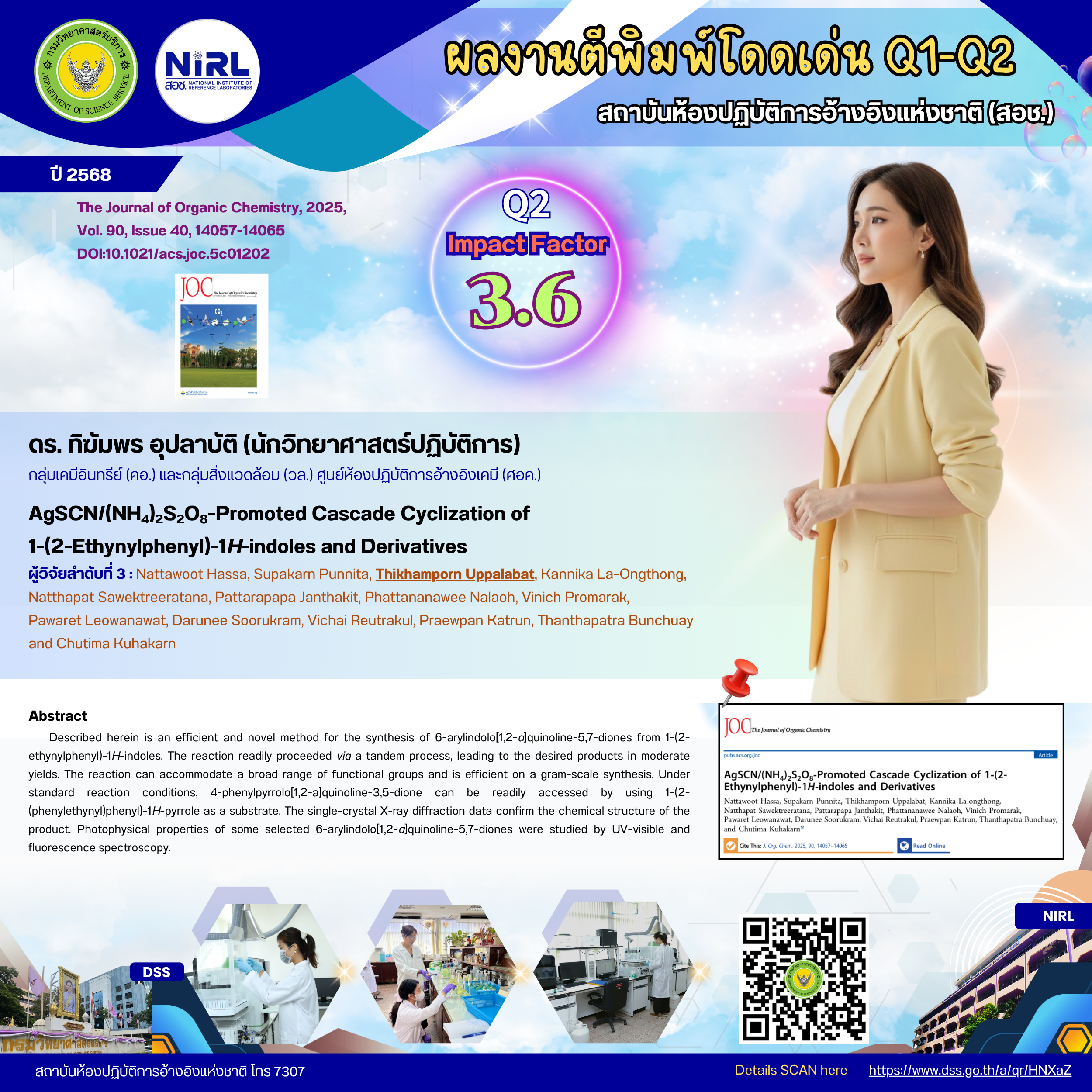
ศูนย์ห้องปฏิบัติการอ้างอิงเคมี (ศอค.)
สถาบันห้องปฏิบัติการอ้างอิงแห่งชาติ (สอช.)
ผลงานตีพิมพ์โดดเด่น High Impact Factor ในวารสารวิชาการนานาชาติ ในระดับ Q1-Q2
ประจำเดือน กันยายน – ตุลาคม 2568
🆕 สถาบันห้องปฏิบัติการอ้างอิงแห่งชาติ (สอช.) ขอประกาศผลงานตีพิมพ์โดดเด่น Q1-Q2 ประจำปี พ.ศ.2568 ที่นักวิจัยและนักวิทยาศาสตร์ของ ศูนย์ห้องปฏิบัติการอ้างอิงเคมี (ศอค.) สอช.ได้เป็นผู้ร่วมตีพิมพ์ในวารสารวิชาการระดับนานาชาติ (International Publications) ที่มี High Impact Factors ในระดับ Quartile tier 1 และ 2 (Q1 และ Q2) ประจำเดือน กันยายน – ตุลาคม 2568 ดังนี้
🧑🔬👩🔬 ดร. อรพรรณ อภิรักษ์กานต์ (นักวิทยาศาสตร์ชำนาญการ), น.ส.อังคณา ขจรวงศ์วัฒนา (นักวิทยาศาสตร์ชำนาญการ) และ ดร. สวรินทร์ สินะวิวัฒน์ (นักวิทยาศาสตร์ชำนาญการ)
🔬- กลุ่มเคมีอินทรีย์ (คอ.) ศูนย์ห้องปฏิบัติการอ้างอิงเคมี (ศอค.)
📑 ผู้ร่วมวิจัย ลำดับที่ 4, 5, 6
Alex Affricano, Alberto Asteggiano, Alice Di Bernardo, Orapan Apirakkan, Angkhana Khachonwongwattana, Savarin Sinaviwat and Claudio Medana, Case study: Targeted HPLC-MS/MS analysis of TFA and other USC-PFAS in beverages and waters from Italy and Asia, Food Control, 2026, Vol 181, 111779
– Impact Factor: 6.3
– Ranking: Q1
– DOI:10.1016/j.foodcont.2025.111779
https://www.sciencedirect.com/science/article/pii/S0956713525006486?via%3Dihub
🧾Abstract
Trifluoroacetic acid (TFA) is an ultra-short chain per- and polyfluoroalkyl substance (PFAS), persistent, highly soluble, and increasingly detected in the environment. This study reports the first systematic screening of TFA and other USC-PFAS in Italy, covering surface, mineral, spring and tap waters as well as alcoholic and non-alcoholic beverages. A total of 172 liquid samples were analyzed with a validated high-performance liquid chromatography–tandem mass spectrometry (HPLC-MS/MS) method. Additional bottled tap and surface waters from China and Thailand were included for international comparison.
Among eight target analytes, only TFA was detected. In Italian waters, concentrations were generally low (0.10–2.02 μg/L; mean 0.39 μg/L), with slightly higher levels in well and surface waters. In contrast, beverages showed markedly elevated concentrations, especially wines (45–407 μg/L; mean 138.8 μg/L), with several red wines exceeding 300 μg/L. Furthermore, the analysis of several wine heritages showed an interesting increase in TFA concentration from 1997 to 2024.
These findings demonstrate a distinct contamination profile of TFA, likely linked to atmospheric deposition, and reveal unexpectedly and high accumulation in wines, suggesting dietary exposure routes beyond drinking water. The work supports the inclusion of TFA in PFAS monitoring and regulatory frameworks and provides a preliminary comparison with Asian regions, where Chinese waters showed higher levels (0.56–1.85 μg/L) and Thai waters were consistently below detection. Finally, the preliminary analysis on wine vintages shows an increase in TFA concentration during the years and paves the way to a future and more throughout systematic study on the increasing presence of TFA in this matrix.

🧑🔬👩🔬 นส. ฐิติพร วัฒนกุล ตำแหน่ง นักวิทยาศาสตร์ชำนาญการ
🔬- กลุ่มเคมีอนินทรีย์ 2 (คน.2) ศูนย์ห้องปฏิบัติการอ้างอิงเคมี (ศอค.)
📑 ผู้ร่วมวิจัย ลำดับที่ 3
Artit Ausavasukhi, Phattraphorn Kijsiri and Titiporn Wattanakul, Highly efficient and hydrophobic phosphotungstic acid supported rice husk silica catalysts for ethanol dehydration: Role of support and water, Surfaces and Interfaces, 2025, Vol. 73, 107569
– Impact Factor: 6.3
– Ranking: Q1
– DOI:10.1016/j.surfin.2025.107569
https://www.sciencedirect.com/science/article/abs/pii/S2468023025018218
🧾Abstract
This research focused on the preparation of phosphotungstic acid (PTA) supported on rice husk silica (RHSi) using a simple and environmentally friendly method. The resulting catalyst was then characterized and applied in the dehydration of ethanol. This catalyst exhibited enhanced catalytic activity when compared to PTA supported on titania (TiO2) and alumina (Al2O3). Under the experimental conditions of 200 °C, a W/F ratio of 13.72 minutes and a 90 wt% ethanol feed, the PTA/RHSi catalyst (with a 13 wt% tungsten loading) achieved 56.72% ethanol conversion and 72.29% diethyl ether (DEE) selectivity. Increasing PTA loading on RHSi improved ethanol conversion. However, excessive PTA loading led to agglomeration, which resulted in an ethanol conversion that was not proportional to the increased PTA content. Silica prepared from rice husk ash via the traditional method (RHASi) exhibited higher hydrophilicity than RHSi. When incorporated with PTA, the PTA/RHASi catalyst demonstrated lower ethanol conversion in the presence of water in the feed, compared to the PTA/RHSi catalyst. These results indicate that the source of the silica support significantly influenced catalytic activity and selectivity, primarily due to variations in acid strength and hydrophobicity. Water in the feed changed selectivity toward DEE and dramatically decreased ethanol conversion, especially for PTA/TiO2 and PTA/Al2O3. A high water content (80 wt% ethanol) deactivated the PTA/RHSi catalyst, primarily attributed to PTA leaching, hydrolysis and substantial water adsorption. While thermal regeneration at 350 °C led to an almost complete recovery of catalytic activity. The PTA leaching is presumed to be the underlying cause of the irreversible efficiency loss.

🧑🔬👩🔬 ดร. ทิฆัมพร อุปลาบัติ ตำแหน่ง นักวิทยาศาสตร์ปฏิบัติการ
🔬- กลุ่มเคมีอินทรีย์ (คอ.) ศูนย์ห้องปฏิบัติการอ้างอิงเคมี (ศอค.)
📑 ผู้ร่วมวิจัย ลำดับที่ 3
Nattawoot Hassa, Supakarn Punnita, Thikhamporn Uppalabat, Kannika La-Ongthong, Natthapat Sawektreeratana, Pattarapapa Janthakit, Phattananawee Nalaoh, Vinich Promarak, Pawaret Leowanawat, Darunee Soorukram, Vichai Reutrakul, Praewpan Katrun, Thanthapatra Bunchuay and Chutima Kuhakarn, AgSCN/(NH4)2S2O8-Promoted Cascade Cyclization of 1-(2-Ethynylphenyl)-1H-indoles and Derivatives, J. Org. Chem., 2025, Vol. 90, Issue 40, 14057-14065
– Impact Factor: 3.6
– Ranking: Q2
– DOI:10.1021/acs.joc.5c01202
https://pubs.acs.org/doi/10.1021/acs.joc.5c01202
🧾Abstract
Described herein is an efficient and novel method for the synthesis of 6-arylindolo[1,2-a]quinoline-5,7-diones from 1-(2-ethynylphenyl)-1H-indoles. The reaction readily proceeded via a tandem process, leading to the desired products in moderate yields. The reaction can accommodate a broad range of functional groups and is efficient on a gram-scale synthesis. Under standard reaction conditions, 4-phenylpyrrolo[1,2-a]quinoline-3,5-dione can be readily accessed by using 1-(2-(phenylethynyl)phenyl)-1H-pyrrole as a substrate. The single-crystal X-ray diffraction data confirm the chemical structure of the product. Photophysical properties of some selected 6-arylindolo[1,2-a]quinoline-5,7-diones were studied by UV–visible and fluorescence spectroscopy.


